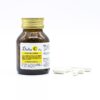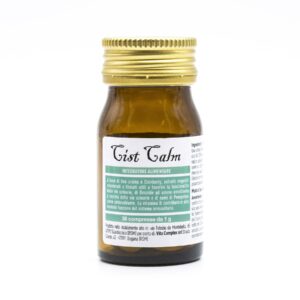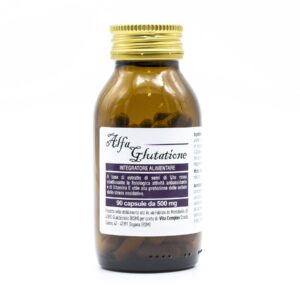PACK:
60 capsules in tinted glass bottle
PRECAUTIONS FOR USE:
This product does not interfere with any other medication and does not have any kind of contraindication. It can even be used by children, the elderly and pregnant women.
MAIN INGREDIENTS:
VITAMIN C NATURAL
INGREDIENTS:
Dog rose (Rosa canina L.) fruit dry extract titrated to 70% in vitamin C, capsule: food gelatin, anti-caking agent: magnesium salts of fatty acids.
Last updated on 08/04/2025
The origin and quality of natural vitamin C is very important. Until now, Vita Complex had chosen acerola, a small cherry from South America, as a source of vitamin C. To further improve quality, Vita Complex has chosen to use another plant, replacing acerola with dog rose, which is extremely rich in vitamin C (from 250 to 4000 mg/100 g, depending on the species).
This new source is another important advantage on monitoring polluting agents that, unfortunately, can be found increasingly frequently in imported plants.
HOW ITS COMPONENTS WORK:
Ascorbic acid or vitamin C, discovered by Albert von Szent-Györgyi in 1933 and studied by Linus Pauling (Nobel prize winner), is involved in an infinite number of biochemical processes. After more than 50 years of research, science is still some distance from knowing all its metabolic paths and all its actions and properties. Generally, it can be said to preserve the body’s homeostasis.
For some, this brutal word means the body’s biochemical balance.
In fact, thanks to an increased production of ascorbic acid, the body maintains a biochemical balance that is continually disturbed by aggressive agents, which are as numerous as they are varied.
This explains the constant need for large amounts of vitamin C.
A correct intake of Vitamin C is therefore important for:
• Helps maintain the normal function of the immune system
• Protects cells from oxidative stress
• Prevents infections (interferon production)
• Protects tissues and blood vessels
• Protects ourselves against pollution and tobacco
• Helps increase the absorption of iron
• Maintains physiological balance
• Contributes to the reduction of tiredness and fatigue
• Protects us from physical and chemical aggression
• Mobilizes heavy metals and facilitate their long-term renal excretion
• Lowers cholesterol
• Contributes to the regeneration of the reduced form of vitamin E
• Contributes to normal psychological function
• Contributes to the normal functioning of the nervous system
• Contributes to normal energy metabolism
In addition, Vitamin C …
• Contributes to normal collagen formation and participates in the normal function of blood vessels and the normal function of bones and cartilage, gums, teeth and skin
• It has a favorable action on cardiovascular and cerebro-vascular disorders and diseases, osteoarthritis, rheumatism, aging, asthma, allergies, transplant rejections, cataracts, ulcers, diabetes and some types of oncological diseases and leukemia.
In its natural form, ascorbic acid is non-toxic, even at high dosages and when taken for long periods, it is eliminated with urine, which is not the case in its synthetic form.
The synthetic form is an inexact copy of the natural vitamin.
Their stereochemical formulas are slightly different, but this is not enough to deceive our body that will either ignore and eliminate most of the synthetic form (from which we deduce the ineffectiveness of low doses), or will accept it, but at the cost of a certain toxicity (in large doses).
Ascorbic acid is water-soluble. This allows it to be quickly removed from urine in the case of overdosing. It is an “essential” vitamin for humans as it cannot be made by the body.
During evolution, an accident made a few rare species, including mankind, dependent on an external supply of this vital substance, depriving it of an enzyme necessary for its elaboration: gulanolactone-oxydase.
Every chemical, physical, or biological attack uses an extra layer of vitamin C.
It is particularly essential for the formation of adrenaline and noradrenaline, hormones that serve to mobilise energy rapidly in the event of an alert. When we are under stress our body causes an acute secretion of steroid hormones in the adrenal corticosteroid and at the same time a collapse in the rate of cholesterol and ascorbic acid in the adrenal tissue.
This shows that vitamin C is directly involved in the synthesis of steroid hormones, starting with cholesterol.
For this reason, it is essential for humans to regularly consume high doses of vitamin C.
RECOMMENDED USES:
we recommend taking one capsule a day, preferably after lunch.
Recommended in combination with: glutathione, NAC, vitamins A, B and E, minerals (Delta A, B, E, Biocean).
CONTRAINDICATIONS:
VITA COMPLEX natural vitamin C has no contraindications.
Synthetic vitamin C, on the other hand, causes heart rhythm problems, digestive problems, headaches. It is destroyed by coffee, cortisone, oxygen in the air, heat (cooking), water and the cold (freezing).
SCIENTIFIC BASES – BIBLIOGRAPHY:
• Corson, Pierre Dr: “Les Indications therapeutiques Vitamine C”, Medecines Nouvelles 4e trimestre 1995
• Corson, Pierre Dr : “Notre ange gardien : la vitamine C”
• Pauling, Linus: “Abusez des Vitamines”, 1981
• Perruchon, Philippe: http://www.natura-clairvi.com “Les Bienfaits de la Vitamine C”
• Souccar, Thierry & Curtay, J-Paul Dr: “Le nouveau guide des vitamines” 2000.
• Anderson, T.W. et al. Vitamine C and the common cold : double blind trial. Can. Med. Assoc. J. 107:503-508, 1972.
• Anderson, T.W. Large scale trials of vitamin C in the prevention and treatment of colds. ACTA Vitaminologica et Enzymologica. 28-99-100, 1974.
• Anderson, T.W. et al. The effects on Win-ter Illness of Large Doses of Vitamin C. J. Can. Med. Assn., Ill, 31-36, 1974.
• Anderson, T.W. et al. Winier Illness and Vitamin C: The Effect of relatively Low Doses. J. Can. Med. Assn., 112, 823-26, 1975.
• Barboriak, J.J. The megadose vitamin con-iroversy. Drug Therapy. May 1974.
• Bates, C.J. et al. HDL-Cholesterol and Vitamin C Stalus. Lancet, 3, 611, 1977.
• Cameron, E., Campbell, A. The Orthomole-kular Treatment of Cancer IL Clinical Trial of high Dose Ascorbic acid Supplements in advanced human Cancers Chemico-Biol. Interaction 9, 285-315.
• Cameron, E. et al. The Orthomolekular Treaiment of Cancer III. Reticulum Cell Sarkome: Double Complete Regression Induced by high-dose Ascorbic Acid
• Cameron, E., Pauling, L. Ascorbic Acid and GI – vcosamino-gIvcans: An orthomolecular approach to Cancer and other Diseases, Oncology. 27, 181-92, 1973.
• Cameron, E., Pauling, L. The orthomolecular Treatment of Cancer: I. The role of ascorbic acid in host resistance. Chemico-Biol., Interactions, 9, 273-83, 1974.
• Cameron, E., Pauling, L. Supplemental Ascorbale in the supportive Treatment of Cancer. Proc. of’ the Nat. Acad. of Sei., USA, 73, 3685-89, 1976.
• Cameron, E., Pauling, L. Vitamin C and Cancer. J. Environm. studies, 10, 303-5, 1977. Cinter, E. Science 179, 702-704, 1973.
• Coulehan, J.L. et al. Vitamin C Propliv-laxis in a Boarding School. New Eng. J_ of Med., 2906-10, 1974.
• Grandon, J.H. et al. Experimenial humait scurvy. New Eng. J. Med. 223-353, 1940.
• Ginter, E. The Role of Ascorbic acid in Cholesterol Catabolism and Atherogenesis. Slovak Academy of Sei., Bratislava, 1975.
• Hawkins, D., Pauling, L. Orthomolekular PsYchiatry, Freeman & Co, San Francisco, 1973.
• Krumdieck, C., Butterworth, G.E. Ascorbat-Cholesterol-Lecithin Interactions : factors of potential importance in the patho genesis of a the roscle rosis, Am. J. of Clin. Nutr., 27, 866-76, 1974.
• McCurdy, P. and Dern, R. Some therapeu-tic implications of ferrous sulfateascorbic acid mixtures. Amer. J. Clin. Nut. 21, 284-288, 1968.
• Mason and Rivers. Plasma ascorbic acid levels in pregnancy. Amer. J. Obs. and Gyn., 1971.
• Milne, J.S. Leucocyte ascorbic acid levels and vitamin C intake in older people. Br. Med. J. 4, 383- 386, 1971.
• Murata, A. Virucidal Activity of Vitamin C for Prevention and Treainiew, of Viral Diseases. Proceedings of the lirst Intersec-tional Congress of Microbiol. Societics, Science Council of Japan, 3, 432-42, 1975.
• Newmark et al. Stability of Vitarnin B 12 in the presence of ascorbic acid, Am. J. of Clin. Nutr., 29,
645-49, 1976.
• Pauling, L. Are recommended Dail ‘ v Alloyances for Vilamin C Adequale ? Proccedings of’ the Nat. Acad. of’ Sci. USA, 71, 4442-46, 1974.
• Pauling, L. Vitamin C and the comnion cold. New York: Bantam Books, 1970.
• Pfeiffer, C., Goldstein, H., Murphree, H. and Nichols, R. A crifical survey of possible biochemical stimulants. Psychopharmacology, 1968.
• Rivers, J. and Devine, M. Plasma ascorbic acid concentrations and oral contraceptives. Amer J. Clin. Nutr. 25, 684, 1972.
• Schwerdt, P.R., Schwerdt, C.E. Effect of Ascorbic Acid on Rhinovirus Replicalion in WI-38 Cells. Proceedings of the Soc. for Exp. Biol. and Med., 148, 1237-43, 1975.
• Yonemoto et al. Enhanced, Blaslogenesis by oral Ascorbic Acid. Ain. Soc. of’ Clin. Oncologists, p. 28, 1976.
• Philippe Lagarde – Guide d’utilisation des vitamines – Ed. Favre
















Reviews
There are no reviews yet.